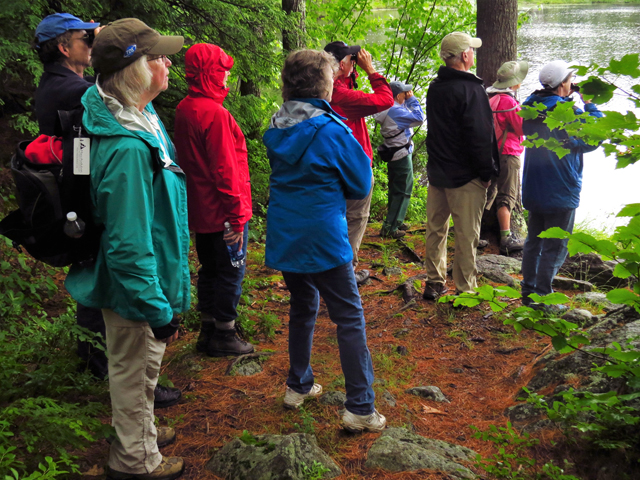
Fifteen of us walked around Hopkins Pond in mid-July, an event sponsored by the Andover Institute in its “Space Exploration” series. That two-hour stroll was a reminder of how much there is to see and hear whenever you stroll through the woods.
Early on, at the western edge of a wetland we noticed many stumps chiseled by beaver incisors. Parts of those trees are now embedded in their dams, while some of the branches may have provided snacks during the long winter. Proctor Academy’s mountain biking team has built some spectacular arched bridges over the small streams in the area.
Walking through a mixed-forest part of the property, we were serenaded by a veery which seemed to stay with us. A member of the thrush family, this singer produces a downward spiral of flute-like notes, similar to the wood and hermit thrush songs in its ethereal quality.
Of course the red-eyed vireo was present and singing much of the time, too. This vireo is one of the most common birds in eastern North America; the Audubon Society estimates one pair per acre. During their breeding season they sing “Here am I. Where are you?” all day, dawn to dusk.
The highlight of our birding was a black-throated green warbler whose “see-see-see-soo-zee” was successfully identified by Anne Hewitt.
Near the southeastern edge of the pond, a short path leaves the trail and brings you to a campsite with a fine vantage point for looking across the water. We could see two loons in the near distance; those with binoculars confirmed we were seeing one adult and its chick.
As if on cue, the adult loon treated us to its beautiful wail, the haunting call that loons give back and forth to figure out each other’s location. Later, we had another look and confirmed that there are two adult loons and one chick on the pond.
Along the edge of the path we saw several mushrooms, mostly amanitas. The only edible fungus was a young Chicken of the Woods we found growing out from the surface of a tree. These shelf mushrooms are easy to identify, with their bright orange and yellow surfaces. Deb Brower harvested just enough to take home for a delectable treat.
It’s important to point out that most mushrooms are not edible; some are deadly, many of the others will make you sick, and all must be cooked before they are eaten.
We had been walking along the Lower Hopkins Trail that passes south of the pond. Shortly after passing an old cellar hole, the trail arrives at a dead end on Proctor’s Bulkhead Road (an extension of Meadowlark Lane). We turned right and walked north along that woods road until we saw the sign for Middle Hopkins Trail, following it as it headed eastward back toward the pond.
Along the path we noticed a tall wildflower with purplish-pink blooms that resembled tiny orchids. Nobody could identify it at the time, but Susan Chase was able to find it later in her Peterson’s field guide: the pointed-leaved Tick Trefoil. As a member of the Pea family, the flowers have five parts, a large upper petal, two smaller lateral petals, and two petals below. ‘Tick-trefoil’ comes from the three-parted leaf on a plant that has barbed hairs (ticks) on the seed pods.
As we approached the boat launch area of the pond we saw evidence of fishing activity, including some line and a bobber hanging from the branches of a shore-edge tree. The pond is stocked annually by New Hampshire Fish & Game (NHF&G) and is a popular place with local anglers. No motorboats are allowed, but rowboats and kayaks are welcome. There are several designated camp sites near the pond.
For more information about the campsites and permission to use one, contact Dave Pilla, Woodlands Manager, at Proctor Academy at 735-5255.
Hopkins Pond, also known as Adder Pond, is one of Andover’s special places. Both NHF&G and Proctor invite the public to use the pond, its shores, and the land surrounding, but they ask that trash be carried out, especially from the access points and camp and picnic sites.
To visit, look for a small parking lot with an information board on Elbow Pond Road, just short of a mile beyond its intersection with Route 11 on the eastern outskirts of Andover Village. You are guaranteed to see something new on each visit during every season.
All of us on the walk that day are grateful to the Andover Institute for offering the outing and to Larry and Susan Chase for their organizational prowess.
Please send your photos, questions, and observations to AndoverNaturally@nullgmail.com.